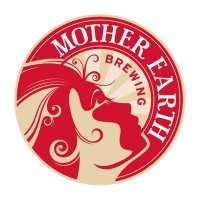Mother Earth Brewing
Mother Earth Brewing is a craft beer brewery located in Kinston, North Carolina. The brewery was founded in late 2008 by owners Stephen Hill and Trent Mooring and began production in 2009.
 | |||||||||||||||||
| Location | Kinston, North Carolina, USA | ||||||||||||||||
|---|---|---|---|---|---|---|---|---|---|---|---|---|---|---|---|---|---|
| Opened | 2009 | ||||||||||||||||
| Active beers | |||||||||||||||||
| |||||||||||||||||
| Seasonal beers | |||||||||||||||||
| |||||||||||||||||
Beers
Mother Earth currently produces four different styles of beer in bottles, an India Pale Ale called Sisters of the Moon; a Kolsch-style ale called Endless River; a Belgian Wit beer called Weeping Willow Wit, and a Munich-style dunkel lager called Dark Cloud. There are also two beers available only in cans; a Pale Ale called Second Wind and a Hefeweizen called Sunny Haze.
Sisters of the Moon IPA is an American style India Pale Ale. The beer is brewed using a variety of hops including Centennial, Amarillo and Saaz hops, and a hopback is used in the brewing process. The alcohol by volume content is 6.9%
Endless River Kolsch is an example of the Kolsch (beer) style which originated in, and is still brewed in, Cologne, Germany. It is characterized by being bright yellow, light-bodied, having a slightly fruity tang, and having some hop presence, although not overbearing. The alcohol by volume content is 4.9%.
Weeping Willow Wit is a Belgian Witbier style ale. This beer is characterized by the use of spices during the brewing process such as orange peel, bitter orange peel, and coriander. The alcohol by volume content is 5%.
Dark Cloud is a Munich-style dunkel lager, aged longer than Mother Earth's other ales. It is a dark colored beer that has tastes of roasted malt in the body. The alcohol by volume content is 5.1%.
Second Wind is an American Pale ale, and uses American hop varietals. It is a medium amber color, and less bitter than the Sisters of the Moon IPA. The alcohol by volume content is 5.0%
Sunny Haze is a Hefeweizen, with wheat being a main constituent of the beer. It is a hazy beer, instead of bright (or clear) and is characterized by fruity esters such as banana, orange, pineapple, and bubblegum flavors. The alcohol by volume content is 4.8%.
In addition to these beers, Mother Earth has three seasonals and a series of fruit beers that are released each year. The Seasonals are 1. Old Neighborhood, a low gravity porter released in the early fall each year, available in 12 oz. bottles. The brewery also produces several experimental batches which are served in their on-site tap room. 2. Tripel Overhead, a Belgian Tripel aged in used Bourbon Barrels, usually released in April. 3. Silent Night, an Imperial Stout brewed with coffee from Raleigh boutique coffee roaster Counter Culture Coffee and also aged in bourbon barrels. Release is December 1 each year. The Windowpane series consists of four fruit beers. In the first quarter, Figs and Raisins is released, a Belgian Dubbel brewed with figs and raisins and aged in Apple Brandy Barrels from the Carolina Distillery in Lenoir, NC. Second quarter sees Raspberry, which is a wheat beer brewed with raspberries and aged in Pinot Noir and Chardonnay barrels. Third quarter is Double Wit Blackberry, aged in Pinot Noir barrels. Finally in the fall Peaches is released, based on an American Wheat beer and aged with the peaches in Chardonnay barrels.
Labels
All of Mother Earth's labels are Eastern North Carolina scenes that come from the minds of the founders Stephen Hill and Trent Mooring and painted by local Eastern North Carolina artist Dinah Sylivant. Mooring and Hill credit the success of Mother Earth Brewing in part of Dinah's artwork. Says Mooring, "Our beers taste great and are very true to style and our labels are very reflective of what it's like to live in Eastern North Carolina. It gives drinkers the warm feeling of what it's like to live in Eastern North Carolina."
Environmental Responsibility
The brewery focuses on being as environmentally friendly as possible. A 4.5 kilowatt solar array stands on the roof and powers Mother Earth's Tap Room. Blue jean insulation, a 100% recyclable product, was used to insulate the walls. In addition to being a recyclable product, it also has outstanding sound barrier qualities. Soy-based spray foam insulation protects the second story ceiling. Low volatile organic compounds (VOCs) paint covers the walls. Mother Earth Brewing's corporate offices sport eco carpet partially made from renewable resources. Eco flush valves reduce water needed for flushing by 30%. Eco faucets in the bathrooms offer an unimaginable savings in water compared to conventional faucets. Tankless water heater heats water on demand, instead of using needless energy to keep hundreds of gallons of water heated at all times.[1][2] Mother Earth Brewing employs green brewing procedures as well. One example grabbed the interest of local farmers. Rather than send spent grain used in the brewing process off to the landfill, it is given to local farmers as top quality feed for their animals-a win-win for all involved. Mother Earth also has planted 25 hop rhizomes penetrating the soil in Kinston.
As of February 12, 2013, Mother Earth Brewing Became First Brewery to Attain LEED® Gold Certification.'
See also
References
- "WNCT". Make It Green. Archived from the original on 2013-02-09. Retrieved 2010-04-05.
- ((cite web | url+http://www.kellymccullen.com/motherearthbrewing))